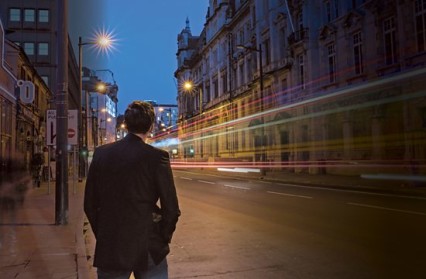Brangwyn Hall, Swansea, 14 April 2016
Conductor: Eric Stern
Electric Violin: Chloë Hanslip
Piano: William Wolfram
Roy Harris: Symphony No. 3
John Adams: The Dharma at Big Sur
George Gershwin: Rhapsody in Blue
Leonard Bernstein: West Side Story – Symphonic Dances
Swansea’s beautiful Brangwyn Hall hosted BBC NOW’s programme of modern American favourites and more.
To open we were treated to a performance of Roy Harris’s Symphony No. 3, a strikingly ambitious piece, known for its thoroughly American aesthetic: by turns heroic, lyrical, pastoral, optimistic and forward thinking. To describe the piece in brief, an opening sweep of smooth strings develops into intricate waves of rippling harmonies; rapidly, elegantly flexing below the surface, almost imperceptibly flickering like the muscles of a ranging animal. This progresses into a more playful exchange of horn and string, evoking the refreshing breezes which tousle the sand about the leaves of tall-grasses in the Great Plains. The whole piece has the feel of musical cartography, exuding gestures of alpine, urban and coastal landscapes. The climax emerges in rhythmic power and jazzy exuberance, surging and throbbing with foreboding, booming, relentless timpani supporting an ominously authoritative, epic tone.
As much as this work charts the wide range of landscapes comprising the U.S., it is also cognisant of 1930s American culture; embracing both its heterodoxy and its unification, and heralding the coming of its age of domination. Conductor Eric Stern cradled Harris’s optimism and cosmopolitanism, highlighting some of the symphony’s underlying experiments, particularly in the opening sections. The spirit of the whole was articulated by a perfectly synchronised string section, backed by bold, organised percussion and horns. Stern showed poise, and skilled judgement of the dynamics in a work full of punctuation. The result was impressive and impactful in extremis, setting the tone for the evening. A delighted audience responded with sustained applause – there was a sense that many in this room were grateful to have been introduced to this unfamiliar piece.
Next was John Adams’s Dharma at Big Sur. Inspired by Adams’s arrival by boat at the cliffy, coastal region of California, Big Sur was composed for orchestra and six-string electric violin. Chloë Hanslip’s glorious performance soared like a seagull above a swelling, mysterious backdrop, reverberating and soothing. Adroitly, she explored the mesh of meditative, swooping untempered sounds with the rich, slick glissando and exulted expressiveness of an electric guitar, without losing the poise and tone of a traditional violin – redolent at once of East and West.
The two additional bass strings on the six-string electric violin give it a breadth of pitch which allowed Adams to deepen the solo melody using the wrenching vocal timbre of the cello whilst preserving the quivering trills of the controlled high-end squeal. At the work’s completion the audience leapt to their feet, applauding, cheering and whistling in admiration.
After the interval we returned for a perfect rendition of Rhapsody in Blue. Stern chose to emphasise the jazz stride of the piece over the usual, warming bluesy slope of the iconic opening melody. The results were exhilarating; a near seismic rumble of feet on wooden flooring accompanying the bows from the solo pianist, William Wolfram, whose playing was as flawless as it was colourful.
Finally it was Bernstein’s ‘Symphonic Dances’ from West Side Story, with which the audience seemed warmly familiar. They were treated to an assured rendition, pounding with energy and crisply articulated rhythms. Stern summoned a faithful and triumphant performance, deft, joyous and fun.
If the first half of the concert was dominated by a Californian spirit – one of progressiveness, experiment and cosmopolitanism – the second half hailed from the East Coast, with all the bluesy, jazzy, Broadway swagger of New York. If it was less challenging or less intellectualised, it was more rousing and charming; sassy, brash and invigorating.
This was a performance by an orchestra full of confidence, comfortable with both late and contemporary classical as well as jazz cross-over, directed by a conductor with a deep sympathy for the musical traditions and national narratives of the U.S.A.
Photo header courtesy of BBC NOW











